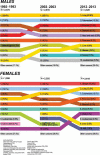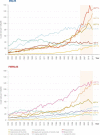Cancer burden in slovenia with the time trends analysis
- PMID: 28265232
- PMCID: PMC5330174
- DOI: 10.1515/raon-2017-0008
Cancer burden in slovenia with the time trends analysis
Abstract
Background: The aim of our study was to describe cancer burden and time trends of all cancers combined, the most frequent as well as the rare cancers in Slovenia.
Patients and methods: The principal data source was the population-based Cancer Registry of Republic of Slovenia. The cancer burden is presented by incidence and prevalence for the period 1950-2013 and by mortality for years 1985-2013. The time trends were characterized in terms of an average annual percent change estimated by the log-linear joinpoint regression. The Dyba-Hakulinen method was used for estimation of incidence in 2016 and the projections of cancer incidence for the year 2025 were calculated applying the Globocan projection software.
Results: In recent years, near 14,000 Slovenes were diagnosed with cancer per year and just over 6,000 died; more than 94,000 people who were ever diagnosed with cancer are currently living among us. The total burden of cancer is dominated by five most common cancer sites: skin (non-melanoma), colon and rectum, lung, breast and prostate, together representing almost 60% of all new cancer cases. On average the incidence of common cancers in Slovenia is increasing for 3.0% per year in last decade, but the incidence of rare cancers is stable.
Conclusions: Because cancer occurs more among the elderly, and additionally more numerous post-war generation is entering this age group, it is expected that the burden of this disease will be growing further, even if the level of risk factors remains the same as today.
Keywords: Cancer Registry of Republic of Slovenia; cancer burden; cancer incidence; time trend.
Figures







References
-
- Bray F. Coleman MP, Alexe D, Albreht T, McKee M. Responding to the challenge of cancer in Europe. Ljubljana: Institute of Public Health of the Republic of Slovenia; 2008. The burden of cancer in Europe; pp. 7–40.
-
- GLOBOCAN 2012 v1.0, Cancer Incidence and Mortality Worldwide: IARC CancerBase No. 11 [Internet] 2013. http://globocan.iarc.fr [cited 25.12.2016]. Available from.
-
- Ferlay J, Steliarova-Foucher E, Lortet-Tieulent J, Rosso S, Coebergh JW, Comber H. et al. Cancer incidence and mortality patterns in Europe: estimates for 40 countries in 2012. Eur J Cancer. 2013;49:1374–1374. - PubMed
-
- Coleman MP, Alexe D, Albreht T, McKee M. Responding to the challenge of cancer in Europe. Ljubljana: Institute of Public Health of the Republic of Slovenia; 2008.
LinkOut - more resources
Full Text Sources
Other Literature Sources
Medical
Molecular Biology Databases
